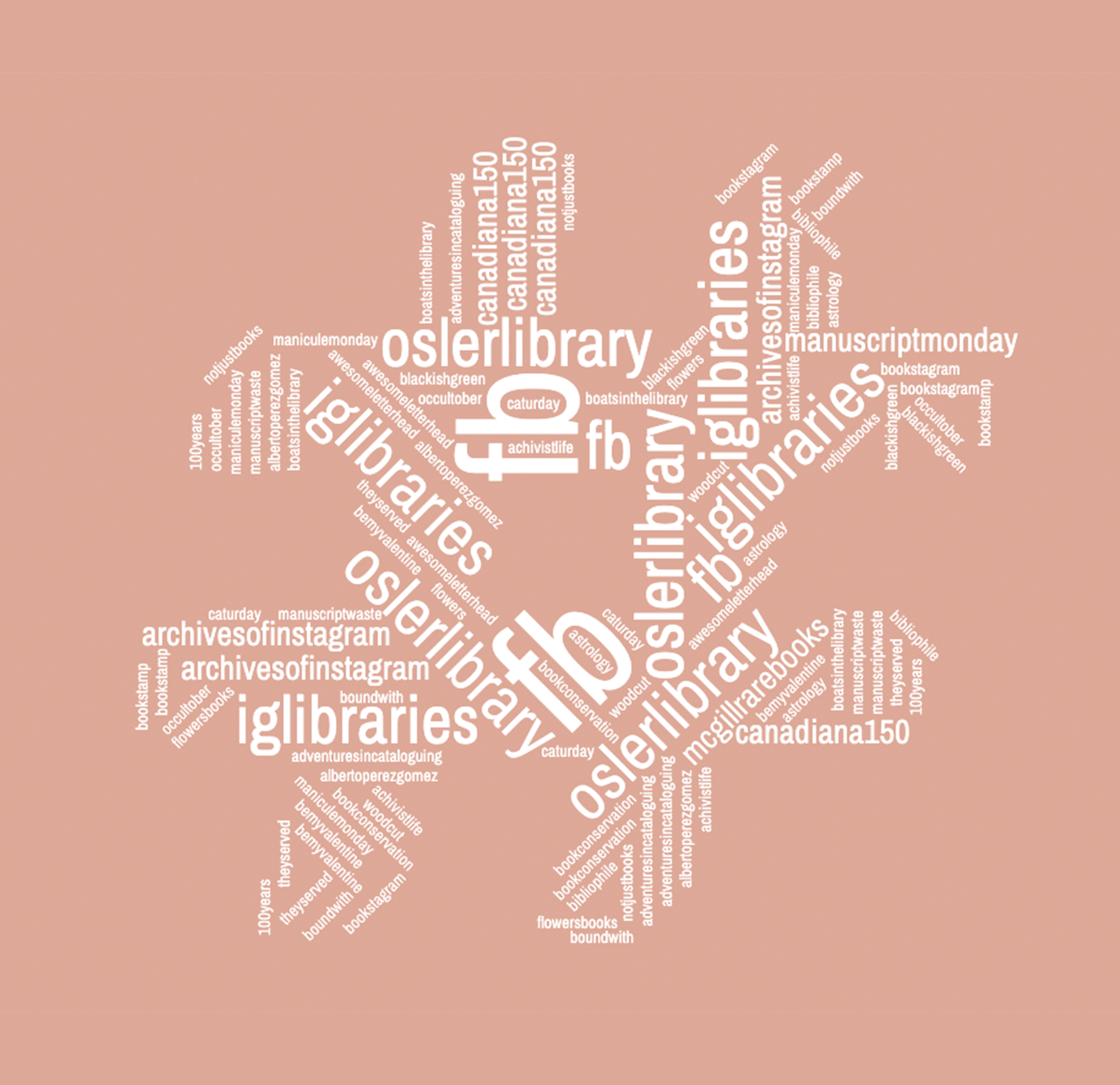Founded as a creative way to highlight McGill’s rare materials and to reach new audiences, the Instagram account @mcgill_rare was started in 2016 by two rare books librarians, a rare books cataloguer, and a digitization librarian. As two of the co-curators of @mcgill_rare, we have spent a lot of time exploring Instagram both as an outreach platform and as a means of connecting with the rare books and special collections community. Of great interest is the growth and complexification of a sprawling rare books community on Instagram, encompassing GLAM (Galleries, Libraries, Archives, and Museums) institutions as well as booksellers, librarians, and enthusiasts. Participants in this network have developed an intricate set of hashtags to describe images of their materials, to locate them within libraries and collections, and to connect with others on Instagram.
This current project stems from the desire to both evaluate the presence and reach of our account and to explore the larger rare books folksonomy in which we participate. We investigate how the community uses and shapes its own folksonomy and, through the social network analysis tool Netlytic, we explore who we are reaching through our participation in this folksonomy. Our interest is informed by current research in web folksonomies and participatory metadata like tagging.

TOWARDS AN INSTAGRAM FOLKSONOMY FOR RARE BOOKS
A folksonomy refers to a community-driven collection of hashtags used on social media that serves as a kind of controlled vocabulary for posts. This shared vocabulary is informal in that there is no official “authority control” in the library sense. Instead, uptake and participation are based on usage by a given community at a given time; all social media users are therefore both creators and adopters of the folksonomy.
For @mcgill_rare, our hashtagging best practices are based on careful observation of, as well as participation within, the rare books community on Instagram. “We” technically refers to our participation in @mcgill_rare as active contributors to the folksonomy and within the Instagram community. Overall, we tag for three reasons:
1. to note where the material in the image is from (collection or library, e.g. #mcgillrarebooks),
2. to describe the content of the image (e.g. #publishersbinding), and
3. to connect with the greater Instagram community (e.g. #librariesofinstagram), including through the use of a combination of themed daily hashtags (like #marbledmonday) and monthly challenge hashtags.
Challenges (like #canadiana150) are generally led by GLAM institutions and aggregated by the account @iglibraries. Most of the tags in the folksonomy are book-centric, but some are wider-reaching hashtags, like #tinytuesday, that have been reappropriated within the context of special collections. The folksonomy operates as a connective thread and as a structuring mechanism. Hashtags for themes and challenges aid in post discoverability, increasing an account’s chances of engagement and outreach. These categories of hashtags (locate/ describe/ connect) also serve as a kind of informal metadata standard for post captions.¹
Image (right): Example of #marbledmonday post @mcgill_rare.
Source: Rare Books and Special Collections, McGill University. Available at https://www.instagram.com/p/BiNigDUAbOo/.
METHODOLOGY
For our explorations, we use a combination of social network analysis and textual analysis. The aim of social network analysis is to better understand how Instagrammers connect and interact with and through the folksonomy. Meanwhile, textual analysis investigates how certain hashtags are used within posts themselves. We chose to use the text and social networks analyzer Netlytic² because it was one of the few tools able to query the Instagram API. There are also several analysis tools built into the interface and the tool allows users to store and manage data in their cloud.
We selected an array of hashtags for our data sample from each kind of usage (i.e., daily tags, weekly, whenever) in the folksonomy. We gathered data over the course of several months and tailored our sampling times for each hashtag to get the best possible sample. For each sample, we instructed Netlytic to query the API every hour, once an hour, which returned the top 100 posts, including comments.
Image (below): Fruchtman Reingold visualisation of #marbledmonday name network from data collected in February 2018 produced in the Netlytic visualizer.
Source: Gruzd, A. (2016). Netlytic: Software for Automated Text and Social Network Analysis. Available at http://Netlytic.org.
PRELIMINARY FINDINGS, UNEXPECTED CHALLENGES
We found that many daily tags reached beyond the library community. For example, #marbledmonday is also used by papermakers and bookbinders. Notable in the dataset for #marbledmonday are the posts of papermakers with lots of engagement (i.e., comments) but fewer likes and followers. Finding @mcgill_rare’s posts in these data proved difficult. Netlytic’s “top 100” metric is determined by engagement, which centres on comments and @s by other instagrammers. Despite numerous likes, we had few comments. This plight appears to be shared by other libraries. Despite the fact that many different communities use #marbledmonday, simply using the shared hashtag does not signal communication between these communities. While the dataset was split between “makers” of books and “libraries,” social network analysis visualizations showed that the two communities did not appear to be influencing or exchanging with one another.

Changes to the Instagram API posed some serious challenges to our data collection.³ The most drastic challenge occurred in the middle of data collection when the API query was no longer able to pull comments on posts. We have adapted our methodology slightly as a result, finished our data collection in its new form, and are currently reframing our path of analysis. Without the comments, we are unable to assess “engagement” as defined by Netlytic, but we are still able to diagram and assess the reach of the hashtags in our sample. We are also working through the full dataset in order to perform our textual analysis of the hashtags.
Already, some bigger picture issues have become apparent. Preliminary observations like #marbledmonday call into question for us what success for a library Instagram account actually looks like, and how it could (or should) be measured. This is a significant question in particular for social media managers who may be required to assess an account’s performance and, potentially, justify time spent. For example, are “likes” an accurate depiction of success in our context? What is a meaningful definition of “engagement” for library purposes? Beyond that, social network analysis raises questions about whom libraries are reaching on Instagram versus who should they be reaching: is it enough to participate in a niche community or must we work towards wide and varied audiences? We hope that ongoing analysis will further help us approach our Instagram practice with intentionality and clear goals.
CONTRIBUTORS
Robin Desmeules
Librarian / McGill University Library
Anna Dysert
Librarian / McGill University Library
SOURCES
1. Parts of this folksonomy have been recorded by @iglibraries in an informal hashtag library. “IG Libraries (@iglibraries).” Accessed April 18, 2019. https://twitter.com/iglibraries/status/948363986579480576; “IG Libraries (@iglibraries).” Accessed April 18, 2019. https://www.instagram.com/iglibraries/
2. For more information about Netlytic see: https://netlytic.org/
3. See Instagram’s acquisition by Facebook and the subsequent move to deprecate the Instagram API: “Instagram Developer Documentation,” accessed June 18, 2019, https://www.instagram.com/developer/; “Instagram Developer Documentation,” accessed June 18, 2019, https://www.instagram.com/developer/.

